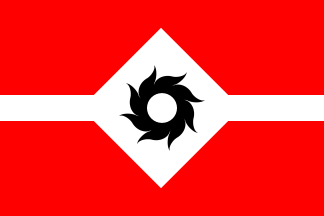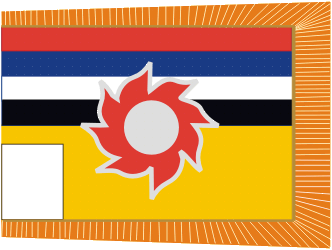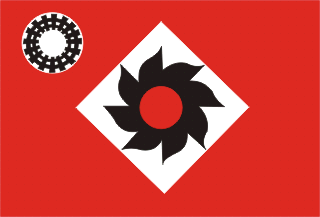![[Flag of Manchuria, 1934-45]](../images/c/cn-ma34.gif)
image by Eugene Ipavec, 24 December 2010

Last modified: 2020-07-31 by ian macdonald
Keywords: manchuria | manchukuo | china | orchid |
Links: FOTW homepage |
search |
disclaimer and copyright |
write us |
mirrors
National flag, Civil ensign and war jack
![[Flag of Manchuria, 1934-45]](../images/c/cn-ma34.gif)
image by Eugene Ipavec, 24 December 2010
Square national flag
![[Flag of Manchuria, 1934-45]](../images/c/cn-mnsq.gif)
Proportions: 1:1; adopted 2 July 1934; depicted in reverse
image by Eugene Ipavec, 24 December 2010
See also:
External Links:
In the 30ies and 40ies great parts of China were occupied by the Japanese.
During this time several "puppet states" have been established. Manchuria or Manzhouguo
(this is the "official" transcription of Chinese used in the PRC, in English it
is often written Manchukuo), located in northeast
China. It existed between 1932 and 1945. Officially it was an empire under the
last Chinese emperor Puyi who used here the name Kangde.
Harald Müller, 11 December 1995
The flag: a yellow field (symbolizing unification), with four horizontal stripes
in the upper right corner: red (bravery), blue (justice), white
(purity) and black (determination).
Bruce Tindall, 9 December 1995
It's interesting that the Manchukuo flag is the Chinese republican one with
the yellow taken out and turned into the field. All the references I've seen gave
red as being for the Han Chinese. The usual interpretation from the Smith book
quoted gives yellow as representing the Manchurians, which would explain its promotion
in the Manchukuo flag.
Roy Stilling, 9 December 1995
The state ensign is the same except that instead of a canton the stripes cover
the top 1/3(+/-) of the flag.
Nathan Augustine, 05 December 1995
There are plenty flag related interesting things on that period to read in a book called Chinese Civil Wars 1911-1949 edited by Osprey in the collection Men at Arms, number 306.
Well, I don't know about that book by Osprey, but I have a book called Flags
of All Nations [smt47] by Smith & Taylor,
1947. This book shows the flag of Manchukuo in
color. The flag's field is a mustard-color yellow. The text description calls
the field yellow. I would call it mustard color (European mustard, not American,
which is real yellow).
Philippe Bondurand, 06 December 1997
Manchukuo was established on 1 March 1932 and Henry Pu-yi was enthroned as Emperor on 1 March 1934.
The country was still called as Manchukuo and sometimes people added Empire to the name.
Nozomi Kariyasu, 24 February 2007
Manchukuo was established on Mar 1st 1932 and changed its name to Empire
Manchukou on Mar 1st 1934 while the national flag was adopted on Mar 1st
1932 by the government decree No 3.
Nozomi Kariyasu, 30 November 2009
I got photo copies of Manchurian flags/emblem important documents from
Japanese National Library:
The English translation of the documents are as follows:
Manchoukuo Government Decree No 3 - March 1st 1932
The National flag The Manchoukuo national flag shall be composed of five colors
and the fly be yellow and red, blue , white and black be in canton the size of
which shall be 1/4 of the size of the whole flag.
Manchoukuo The State Department Decree No 3 - February 24th 1933
The meaning of the National Flag
We had notified earlier that our Manchoukuo National flag of five colors was
adopted. We hereunder make an interpretation of the meaning of the flag which
the people of Manchoukuo shall know. The blue stands for the East, the red for
the South, the white for the West, the black for the North and the yellow for
the Central. The whole flag symbolizes that the central government rules all
around.
Nozomi Kariyasu, 06 February 2010
![[Manchoukuo army red cross flag]](../images/c/cn-marc.gif) Proportion: 1:1
Proportion: 1:1
image by Eugene Ipavec, 17 January 2007
A red thin cross on white; adopted on 2 July 1934.
This flag was hoisted together with the square national flag
Nozomi Kariyasu, 17 January 2007
![[Manchoukuo postal flag, 1935-1945]](../images/c/cn_manps.gif)
image by Eugene Ipavec, 24 December 2010
The flag of Manchoukuo postal system. The postal insignia appears to have been
adopted around 15 September 1935 and used until 1945. The insignia represents
the Chinese word yu, using however, 2 of the 40 ideographs. In the insignia,
the first character of the yu was turned 90 degrees and the second character
was made symmetrical so that both the obverse and reverse were identical.
Phil Nelson, 26 January 2000
This nice site shows (mostly clickable) Manchukuo stamps and related images:
http://www.manchukuostamps.com/
and of course a number of them show the national flag.
See also the 'Revenues' section on the Kwantung Leased Territory (nominally
Manchukoan) featuring stamps with a Japanese flag.
Jan Mertens, 16 November 2009

image by Eugene Ipavec, 24 December 2010

image by Jaume Ollé, 01 December 2009
Adopted on Jun 28th 1945 by Official Bulletin No 3305. The marigold flag
charged with red, blue, white, black horizontal stripes upper half and white sun
with red eight rays in the center with gold fringe.
Nozomi Kariyasu, 01 December 2009

image by Jaume Ollé, 01 December 2009
Mancukuo Peaceful Corporation Youth Railways Corps flag Adopted on Mar 1st
1945 by Official Bulletin No 3245. The red flag charged with black rails in
white circle in canton and red sun with black eight rays in white square in the
center.
Nozomi Kariyasu, 01 December 2009